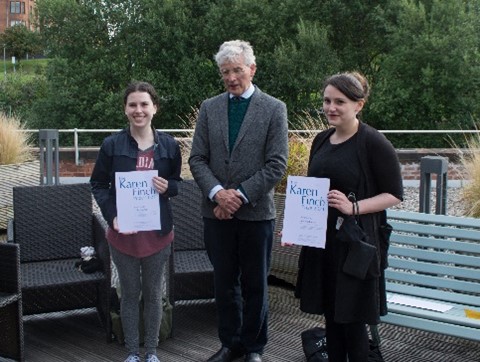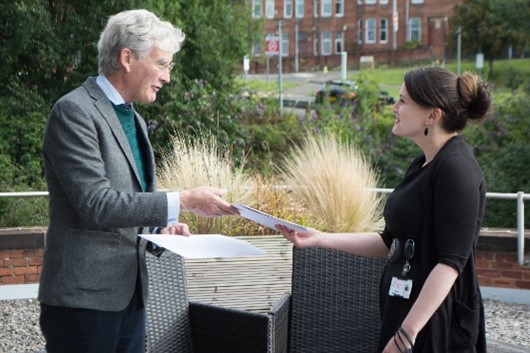
As another academic year starts at the University of Glasgow, it seems like a good time for a catch up of all that has been happening – a bit like one of those ‘round robin’ letters that come in Christmas cards (except in September and hopefully not as smug!).
Looking back, we achieved a remarkable amount last year despite spending the majority of it in one form of lockdown or another. Armed with an 18-page risk assessment we managed to fulfil all practical elements of the programme without a single case of the virus, armed with some instructional videos we learnt to teach, and learn, via Zoom and armed with a lot of polythene, a new name (the Kelvin Centre for Conservation and Cultural Heritage Research) and Nicole we even survived a rather ‘spontaneous’ re-location to Kelvin Hall.
More significant still are the changes within the Kelvin Centre team – the comings and goings.
In April Frances Lennard, Professor of Textile Conservation retired.
Frances was responsible for the establishment of textile conservation at the University of Glasgow, building on the legacy of the Textile Conservation Centre. She was the Programme Convenor from 2002-2017 and Director of the Centre for Textile Conservation and technical Art History, 2016-2020. Building on her experience as a practitioner, Frances has taught and inspired generations of textile conservators as well as leading a number of major and ground-breaking research projects, publishing extensively. She will continue as an Honorary Professorial Research Fellow at the University of Glasgow. Although restrictions meant that we have not yet been able to celebrate with colleagues within the university, but we did manage a socially distanced mini-farewell on the last day of the semester.


In June, Dr Margaret Smith, Conservation Scientist also retired.
Margaret had been a cornerstone of the Centre for the last 6 years as she taught on both the textile conservation and technical art history programmes, and made a significant research contribution in both disciplines, including as research associate for the Situating Pacific Barkcloth in Time and Place project, co-investigator for the PISTACHIO:Photonic Imaging Strategies for Technical Art History and Conservation project and working with Karen on painted textiles. From her 25 years in academia and the industry she brought a wealth of experience in analytical techniques, materials science and working on multidisciplinary projects which she shared generously with both students, colleagues and the profession through her extensive publications. She will continue as an Affiliate and we hope she will come back and work with us on special projects soon.
Similarly scuppered in terms of a mass gatherings, we did manage a small, trackable and traceable trip to the pub, which felt exotic enough at the time.



In June we were delighted that Joanne Hackett joined us as Lecturer. Coming from the Victoria and Albert Museum where she was Head of Textiles and Fashion Conservation, Jo brings a fantastic amount expertise in textile conservation. A graduate of the Wintherthur/University of Delaware programme with a major in textiles, Jo has worked in both the US and the UK and has extensive experience of textile and other materials and their conservation and research as well as other aspects of conservation practice in a museum environment such as managing exhibitions, loans, outreach and public engagement (as seen here on TV with Pumpie).
Even more recently Dr Paul Garside has joined us as Conservation Scientist. Paul studied for a Master of Chemistry degree at the University of Southampton, staying on for his doctoral research on the characterisation of natural polymer fibres in historic textiles. His association with the Textile Conservation Centre began there, as a postdoctoral Research Fellow with a particular interest in plant fibres and weighted silks and as a lecturer on the Centre’s MA course in Textile Conservation. Since 2009 his role as Conservation Scientist at the British Library where his research interests have included risk management, iron gall ink and conservation storage solutions.
And last, but by no means least we have bid farewell to the academic cohort of 2019-21. They have shown great fortitude in weathering the storms of the last 2 years and will take that strength and resilience, patience and good humour into their future careers. Unfortunately we weren’t able to get everyone together, but managed a wee, alfresco prize giving for:
Yufei Xiang (bottom left) – winner of the Worshipful Company of Woolmen prize
Anna Robinson (top right) and Callie Jerman (top left) – joint winners of the Karen Finch prize.
We are delighted for the prizewinners but also applaud the success of all the students and wish them all the very best as they emerge as professionals.








